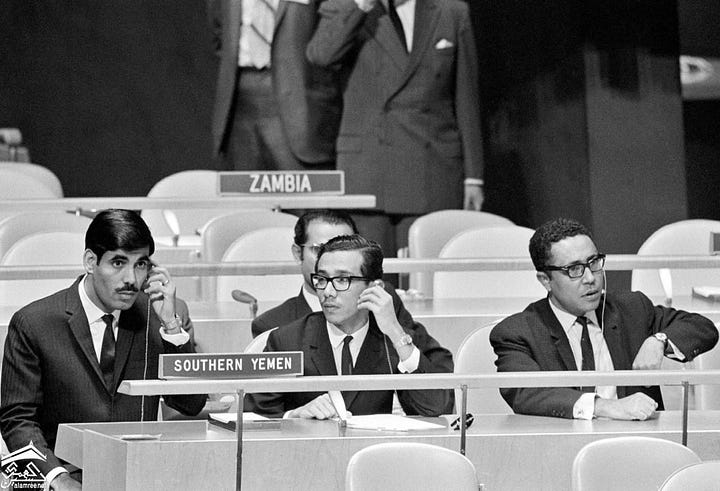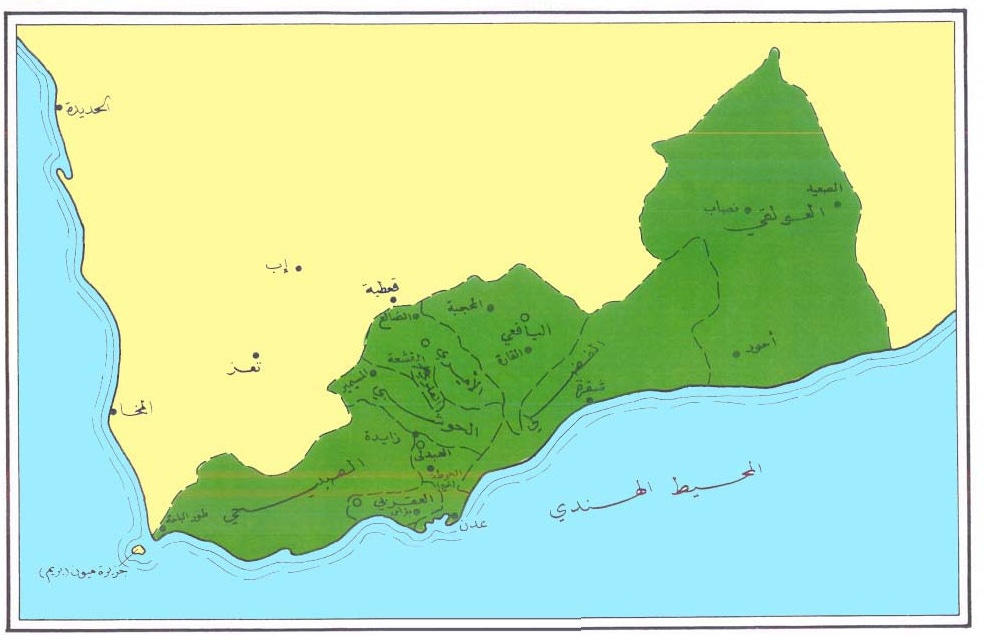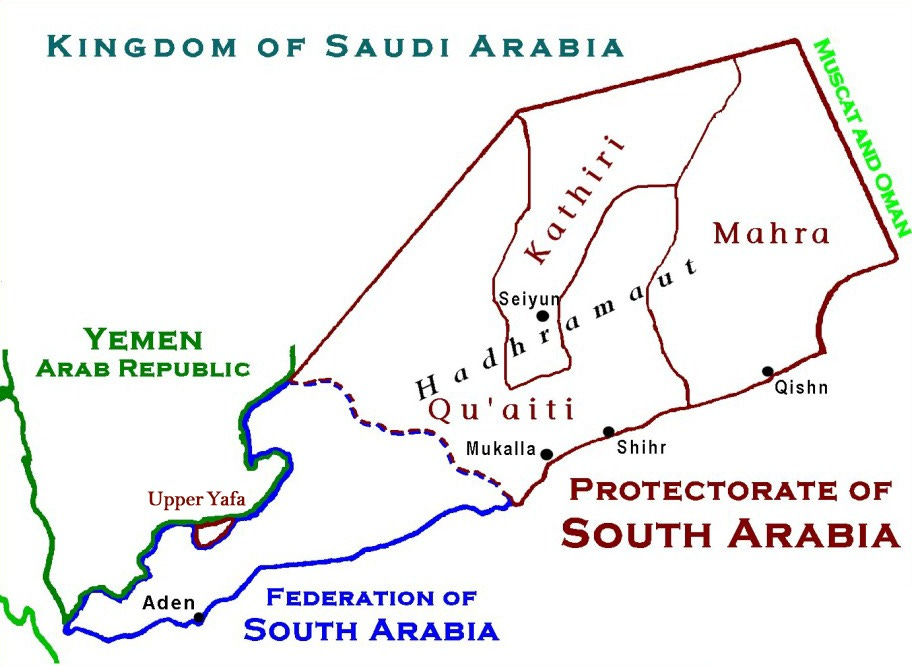North and South Yemen–Geographically and officially incorrect names!
Where did those names come from?
If you have looked into the history of Yemen, you may have encountered a map similar to the one below. Before unification in 1990, there were two distinct Yemens: the Yemen Arab Republic, commonly known as "North Yemen," and the People's Democratic Republic of Yemen, referred to as "South Yemen." However, these names can be misleading; the geographical placement of the two regions resembles more of an East and West division than a North and South one, as the South included territories that extended far north and vice versa. So, where did these names originate?

The division of Yemen began when the British invaded the Abdali Sultanate of Lahej and captured the port city of Aden. Following this invasion, the British established informal treaties of protection with nine sheikhdoms and sultanates in the surrounding region. These included the Abdali, Alawi, Amiri, Aqrabi, Aulaqi, Fadhli, Haushabi, Subeihi, and lower Yafi'. The British aimed to expand their influence in this area to secure control of the important port, which was then under British Raj governance. Although the Ottoman Empire accepted some protection arrangements, it maintained control over its vilayet to the north.
Britain's new "protection policy" was supported by local rulers who wanted to remain independent from the Ottoman Empire. These rulers welcomed Britain's offer of weapons and financial assistance in exchange for protection. As a result, this led to the preservation of tribal divisions and a cessation of conflicts within tribes, as Britain strengthened the authority of sultans, emirs, and sheikhs.
The British began signing formal treaties, starting with the State of Mahra in 1886, and by 1954, they had signed more than 30 major protectorate treaties. These treaties, along with several other minor agreements, contributed to the establishment of the Aden Protectorate, which extended east of Aden and into Hadhramaut, excluding the actual city of Aden, which was governed under the British Raj and later became a crown colony.
In 1914, following an agreement with the Ottomans in 1913 known as the “Anglo-Ottoman Convention of 1913” or the “Blue Line,” the British and the Ottomans divided the Arabian Peninsula into two parts: the northwest under Ottoman control and influence, and the southeast under British control and influence. Although a further agreement, the Violet Line, was negotiated, the Ottomans planned an invasion of the Aden Protectorate in cooperation with local Arab tribes. They had gathered significant strength at Cheikh Saïd.
On 5 November 1914, the British declared war on the Ottomans, who responded with their own declaration a few days later, on 11 November. Although the Ottomans managed to capture the Sultanate of Lahej and reach the city of Aden, they were later expelled by the British. Around the same time, the British-sponsored "Arab Revolt" in the Hejaz broke out, diverting Ottoman attention from Aden and effectively ending their campaign.
The "Armistice of Mudros," signed in 1918, officially concluded the war and forced the Ottomans out of Arabia, leading to the establishment of the "Mutawakkilite Kingdom of Yemen."
In 1937, the protectorate was informally divided into two regions: the Eastern Protectorate, with a British political adviser based in the Qu'aiti Sultanate at Mukalla, and the Western Protectorate, with an adviser based in the Sultanate of Lahej, to facilitate separate administration. After World War II ended in 1945, Aden experienced a significant economic boom, becoming the second most active port in the world, following New York. Labor unions emerged, attracting large numbers of workers from Taiz in the north, who ultimately outnumbered the non-Arab traders identified as the "citizens of Aden" at that time.
Since citizens of Aden enjoyed rights and privileges unavailable to either the subjects of the protected states or the workers from Taiz, Muhammad Ali Luqman, an Adeni lawyer and politician, founded the first Arabic literature club and the first Arabic school in Aden. Luqman’s group was the first to conceptualize Yemeni unity, with Luqman playing a crucial role in the Waziri Coup of 1948 in the Kingdom of Yemen.
In 1952, Arab nationalism began to sweep across the Arab world, starting in Egypt, accompanied by anti-colonial sentiments. Nationalist pressures prompted the rulers of the Aden Protectorate states to renew efforts at forming a federation. On 11 February 1959, six of these states signed an accord to form the Federation of the Emirates of South Arabia. Over the next three years, nine additional states joined, and on 18 January 1963, Aden Colony was merged with the federation, creating the new Federation of South Arabia. Meanwhile, the eastern states that did not join the federation became the Protectorate of South Arabia, marking the end of the Protectorate of Aden.
In 1962, a successful coup carried out by the Free Officers Movement in Yemen, supported by Egyptian President Gamal Abdel Nasser—who had led the Egyptian Revolution of 1952 against British rule—resulted in the fall of the Kingdom of Yemen and the establishment of the Yemen Arab Republic. This coup inspired revolutionary groups, such as the Movement of Arab Nationalists, to form the National Liberation Front (NLF), led by Qahtan al-Shaabi, in the Federation of South Arabia, located south of the Yemen Arab Republic.
The conflict in the north spread throughout the region, starting with the first uprising in Radfan on 14 October 1963. By 10 December 1963, a state of emergency was declared in the State of Aden. The NLF's campaign for power expanded throughout the Federation in 1964. During the same year, a new government led by the Aden Labour Party won the United Kingdom general election and attempted to grant independence to the Federation of South Arabia by placing Abdullah al Asnag—a labor leader in the Aden Trade Union Congress—in control of the country.
After four years of fighting against the British, the NLF defeated them and quickly captured the Protectorate of South Arabia to the east. The naming inaccuracy arose after the Aden Emergency ended on 30 November 1967; the NLF established the People’s Republic of Southern Yemen (PRSY). Many eastern members of the NLF opposed this name and sought to create a breakaway state called the People’s Democratic Republic of Hadhramaut, but their efforts failed.
Following the establishment of the PRSY, it officially adopted the short name “Southern Yemen.” This, in turn, led to the Yemen Arab Republic being informally referred to as “North Yemen.” Despite the Marxist faction of the NLF coming to power after a coup known as the “Corrective Move” on 22 June 1969 and renaming the country to the People’s Democratic Republic of Yemen, with the official short name changing to Democratic Yemen, the name “Southern Yemen” had already become entrenched in the culture. People in the region continued to refer to themselves as Southerners, a term they had used even before the Aden Emergency.


The text of this page is available for modification and reuse under the terms of the Creative Commons Attribution-Sharealike 4.0 International License and the GNU Free Documentation License (unversioned, with no invariant sections, front-cover texts, or back-cover texts).







this was an amazing topic, make more please!
Jazakallahu Khair, this was really insightful and needed as i have been finding it quite difficult to get historical and political information about Yemen. My mother is Yemeni and grew up in Aden during the 90s. Nice to know a bit of what the political situation looked like and explains why it was a pretty turbulent childhood. Look forward to the rest of your posts inshallah.